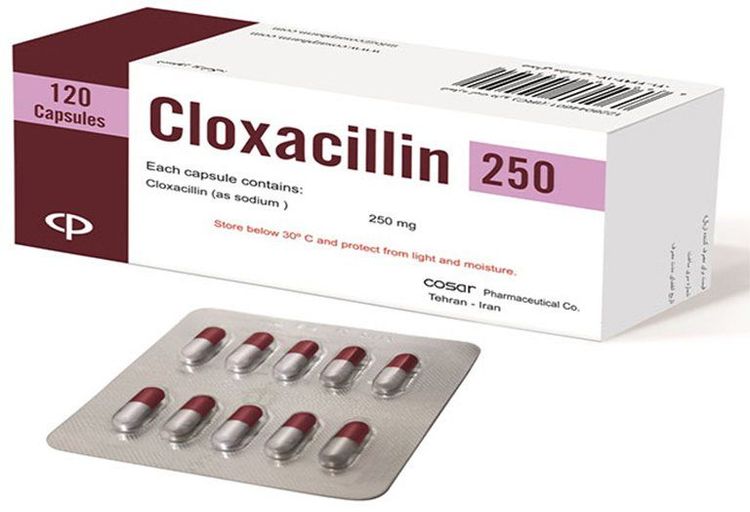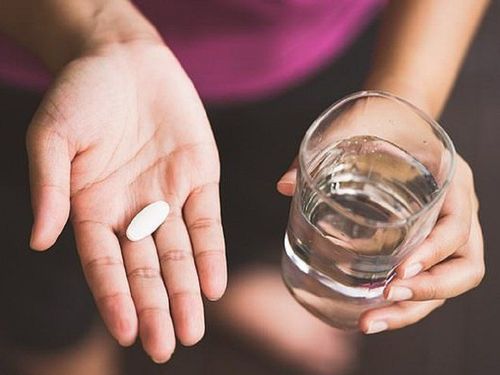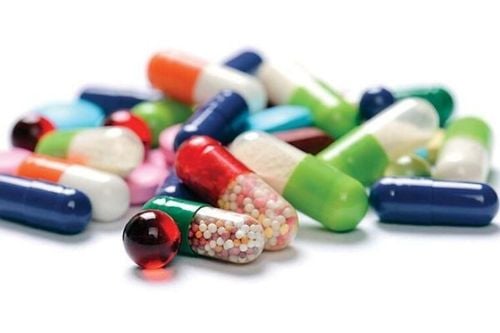This is an automatically translated article.
Cloxacillin belongs to the group of antibiotics with bactericidal effect, inhibiting the biosynthesis of bacterial cell walls such as benzylpenicillin, but resistant to Staphylococcus penicillinase.1. What is Cloxacillin antibiotic? Cloxacillin side effects
Cloxacillin is a bactericidal antibiotic that inhibits bacterial cell wall synthesis such as benzylpenicillin, but is resistant to Staphylococcus penicillinase. Therefore, the drug is active against penicillinase-producing or non-penicillinase-producing Staphylococcus with a minimum inhibitory concentration of about 0.25 - 0.5 microgram/ml. However, the antibiotic Cloxacillin is not active against methicillin-resistant Staphylococcus aureus (MRSA) because the bacteria have modified penicillin-binding proteins (PBPs).Activity against Streptococcus bacteria is less than that of benzylpenicillin, but is generally sufficient when these bacteria are present in the presence of penicillin-resistant Staphylococcus. Cloxacillin is not effective against Enterococcus faecalis.
Cloxacillin crosses the placenta and is excreted in breast milk. The drug does not diffuse into the cerebrospinal fluid unless the meninges are inflamed. Therapeutic concentrations of the drug can be achieved in pleural fluid, synovial fluid and in bone.
Cloxacillin is metabolized to a limited extent. The unmodified antibiotic Cloxacillin and its metabolites are excreted in the urine by glomerular filtration and tubular secretion. Approximately 35% of an oral dose is excreted in the urine and up to 10% in the bile.
Cloxacillin antibiotics are indicated for treatment in the following cases:
Cloxacillin antibiotics are used similarly to flucloxacillin in the treatment of bacterial infections caused by benzylpenicillin-resistant staphylococcus. Cloxacillin is an antibiotic for parenteral use and is effective in the treatment of serious infections caused by either penicillinase-producing or non-penicillinase-producing Staphylococcus when high plasma concentrations are required. Types of infections including bone and joint infections, endocarditis, peritonitis (associated with continuous outpatient peritoneal dialysis), pneumonia, skin diseases (including soft tissue infections) and prevention of surgical infections. Cloxacillin is an oral antibiotic used for the initial treatment of mild and moderate infections caused by staphylococci or non-penicillinase-producing staphylococci or for subsequent treatment after parenteral therapy for severe infections. . Do not use the oral antibiotic Cloxacillin in the treatment of meningitis.
2. What are the dosage forms of Cloxacillin?
Cloxacillin antibiotics have the following forms and strengths:
Cloxacillin 250 mg capsules; Cloxacillin 500mg bp capsules ; Cloxacillin powder 250 mg; 500 mg; Cloxacillin 125 mg solution.

Hình ảnh thuốc kháng sinh Cloxacillin được bào chế ở dạng viên nang
3. Undesirable effects of the drug Cloxacillin
Common unwanted side effects, such as:
Digestive disorders: Nausea, diarrhea (for people taking Cloxacillin antibiotics and depending on the dose); Skin: rash, itching (about 4% of people injected with Cloxacillin); Other signs: Thrombophlebitis after intravenous administration. Uncommon side effects, such as:
Skin: urticaria; Blood: Increased eosinophils. Rare side effects, such as:
Systemic: Anaphylactic reactions; Blood: leukopenia, agranulocytosis; Gastrointestinal: Pseudomembranous colitis; Liver: Cholestatic jaundice; Urogenital - Genitourinary: Renal dysfunction accompanied by elevated serum creatinine. Note:
Pseudomembranous colitis is caused by Clostridium difficile overgrowth and toxins. In this case, it can be treated with metronidazole. Elderly or susceptible people need to be aware of this undesirable effect.
4. Administration and dosage of Cloxacillin
4.1. How to take Cloxacillin The antibiotic Cloxacillin is usually prescribed for oral use or injection (intramuscular, intravenous, infusion) as the sodium salt. Cloxacillin should be taken one hour before or at least two hours after eating, because food in the stomach can cause reduced absorption of the drug. Cloxacillin can be administered by intra-articular injection, intrapleural injection and inhalation. In general, patients with impaired renal function do not require dose reduction, unless the renal impairment is severe. The antibiotic Cloxacillin can be used in combination with other antibiotics such as ampicillin to create a broader spectrum of action against penicillinase-resistant bacteria. Cloxacillin benzathine is for veterinary use only. 4.2. Dosage of Cloxacillin For adults
Infections of the skin and connective tissues: Oral 250 - 500 mg/time ie 1 tablet of Cloxacillin 500 mg bp, 4 times a day or 250 - 500 mg intramuscularly, every 6 hours ; 250 - 500 mg slow intravenous injection over 3 - 4 minutes, 3-4 times in 24 hours. Endocarditis caused by Staphylococcus: Continuous infusion of 6g/for 24 hours. Sepsis or meningitis: 100 mg/kg body weight intravenously over a 24-hour period divided into 4-6 injections. The duration of treatment with the antibiotic Cloxacillin depends on the type and severity of infection and on the clinical and bacteriological response. For most staphylococcal infections, therapy lasts at least 14 days; Longer periods may be required for osteomyelitis, endocarditis, or other foci of infection. For children
Newborns 7 days old or younger, weighing less than 2kg: 25 mg/kg orally or intravenously every 12 hours. Infants 7 - 28 days old, weighing less than 2 kg or children 7 days old or younger weighing 2 kg or more: 25 mg/kg every 8 hours, orally or intravenously. Children 7 to 28 days old, weighing 2 kg or more: 25 mg/kg every 6 hours, orally or intravenously. Children ≥ 1 month old, weighing less than 20 kg: 50-100 mg/kg/day (maximum 4g) divided into 4 times a day, orally or intravenously or intramuscularly. For severe infections: Dosage can be up to 200 mg/kg/day (maximum 12g), divided into several times, can be administered intravenously. Children ≥ 1 month old, weighing 20 kg or more: Use the same therapeutic dose as adults. Overdose and toxicity can cause vomiting, prolonged diarrhea, convulsions, paralysis, and even death. How to handle overdose: You need to reduce the dose, stop taking the drug immediately. At the same time, you need to contact and immediately go to the nearest medical facility. Doctors will prescribe treatment for poisoning or allergies as with benzylpenicillin.
In case of missed dose: You need to take a missed dose as soon as you remember it. If the time gap is close to taking the next dose, skip the missed dose and go back to the normal time. Never use 2 doses at the same time or add more doses.

Thuốc kháng sinh Cloxacillin cần được sử dụng đúng liều chỉ định của bác sĩ
5. Cloxacillin antibiotic interactions
The combined use of the antibiotic Cloxacillin with other aminoglycoside drugs in vitro will cause significant mutual inactivation. If it is necessary to take both antibiotics, the doctor will prescribe the injection at two different sites, at least 1 hour apart.
Concomitant use of high doses of the antibiotic cloxacillin with anticoagulants (coumarin, heparin or indandion derivatives) may increase the risk of bleeding caused by penicillins that inhibit platelet aggregation and therefore require Carefully monitor for signs of bleeding.
Cloxacillin should not be co-administered with thrombolytics because it may increase the risk of major bleeding. The use of the antibiotic Cloxacillin with hepatotoxic drugs may further increase the degree of hepatotoxicity.
Cloxacilin blood levels increase if used in combination with probenecid because probenecid reduces the renal tubular secretion of penicillins and increases the risk of toxicity if used together. Drug interactions can change how a drug works or increase the effect of unwanted side effects. You should write a list of all the medicines you are taking (including prescription, nonprescription and dietary supplements) and show them to your treating doctor.
6. Note when using Cloxacillin
Take the correct dose of Cloxacillin as directed even if your symptoms may start to improve before the infection is completely treated.
Do not break, crush or chew the capsule and swallow it whole. The antibiotic Cloxacillin can reduce the effectiveness of birth control pills. Use another method of birth control such as condoms while taking Cloxacillin for better contraception.
Caution for all manifestations of allergy or hypersensitivity after using therapeutic drugs. The drug must be discontinued immediately and emergency facilities prepared, to prevent anaphylaxis in people treated with beta-lactam drugs.
Cloxacillin should be used with great caution in neonates, preferably not because of the risk of hyperbilirubinemia due to competition for binding to serum proteins (causing nuclear jaundice). .
Cloxacillin antibiotic has bactericidal effect. To ensure effective use and avoid unwanted side effects, you should carefully read the instructions or strictly follow the instructions of the treating doctor.
Please dial HOTLINE for more information or register for an appointment HERE. Download MyVinmec app to make appointments faster and to manage your bookings easily.













